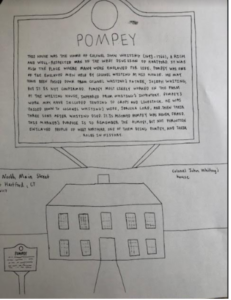Location: 34 North Main Street, West Hartford, Connecticut
Pompey: Mark His History
A student essay by Jenny Zhao

Around our town, there are public history markers in certain areas and buildings to remember their significance in our history. At Goodman Green, a strip of land given by Timothy Goodman to the West Hartford Parish of the Congregational Church in 1747, a sign marks and explains the importance of the land. I would like to install another sign with the same purpose of making the town’s history known, but it will focus on remembering the enslaved people held in this town.
Our team has done research on an enslaved man named Pompey, who was held by Colonel John Whiting in the 1700s. Colonel Whiting was a respected and wealthy man in the West Division of Hartford, now known as West Hartford. He owned land and houses in three different towns. He was Treasurer for the Connecticut Colony and commanded a regiment in the French and Indian War. Church records show that Whiting gave a piece land to the church, bought a family pew, and was chosen as moderator many times. But, another prominent aspect of Colonel Whiting was that he enslaved people.
Through analyzing wills and records, we discovered that Whiting held many enslaved people in his lifetime, one of them being Pompey. Although not much is known about Pompey, he still must be remembered, as he was a part of West Hartford’s history.
In the 1717 inventory of Colonel Whiting’s father, Joseph Whiting, there is a “negro boy” listed. It is possible that boy was Pompey, which means he would have been passed down from Joseph Whiting to his son, Colonel Whiting. The passing down of enslaved people was a common practice. It was an example of the fact that enslaved people were treated as property. This is shown again in Colonel Whiting’s will. Whiting wrote, “I give and bequeath unto my loving wife Jerusha . . . my Negro man named Pompey all during his natural life.” But, Whiting also made plans for Pompey for after he and his wife both passed. He wrote, “I give and bequeath unto my three sons, John, William, and Allen, my servant man Pompey (after the decease of my wife).” This ensured Pompey would not be freed, and would remain enslaved by the Whiting family for life. By looking at Colonel Whiting’s inventory, we can infer that Pompey worked on Whiting’s farm. Livestock, plows, and a cider mill were listed in the inventory. Pompey could have tended to Whiting’s animals or plowed the fields while held by Whiting. While some enslaved people were baptized or became church members, there are no records listing Pompey’s activity in church.
Combining the idea of the Witness Stones Project and the public history markers, I would like to place a marker in front of Colonel Whiting’s old property at 291 North Main Street, West Hartford, Connecticut. It would serve as a reminder that Whiting enslaved people at that very site. This marker would specifically be about Pompey and his life. I want to model the marker after the sign for Goodman Green and Meeting House Corner, as I think it will stand out more. Its purpose is to spread awareness about slavery in West Hartford and remember Pompey, a lesser-known but important part of our history who shouldn’t be forgotten.
